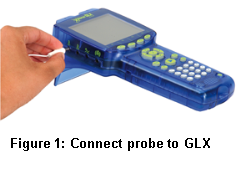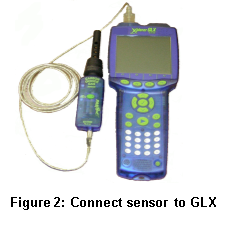|
Biology: Respiration, fermentation |
GLX setup file: grape juice.glx |
|
Qty |
Equipment and Materials |
Part Number |
|
1 |
PASPORT Xplorer GLX |
PS-2002 |
|
1 |
PASPORT CO2 Gas Sensor |
PS-2110 |
|
1 |
PASPORT Extension Cable |
PS-2500 |
|
1 |
PASPORT Fast-Response Temperature Probe (included with GLX) |
PS-2135 |
|
1 |
Sampling Bottle (included with sensor) |
|
|
1 |
Balance |
SE-8723 |
|
1 |
Beaker, 1 L |
SE-7288 |
|
1 |
Beaker. 250 mL |
|
|
1 |
Graduated Cylinder |
SE-7289 |
|
1 |
Hot Plate |
SE-8767 |
|
1 |
Magnetic stirrer with stir bar |
|
|
5 mL |
Mineral oil |
|
|
1 |
Pipette |
|
|
1 g |
Sodium fluoride, solid |
|
|
1 pkg. |
Yeast, dry |
|
|
1 L |
Water |
|
|
1 |
Weighing paper |
The purpose of the activity is to explore the rate of fermentation. Measure the production of carbon dioxide gas in a sampling bottle containing yeast and grape juice and then measure the gas production when a chemical inhibitor is added to the grape juice/yeast mixture.
All organisms require a source of energy to maintain cell physiology and growth. Cellular respiration is the process utilized to oxidize food molecules and release the energy to fuel life processes.
There are two types of cellular respiration – aerobic and anaerobic – and both begin with glycolysis. Glycolysis is a biochemical process utilized by most microorganisms (yeast, bacteria) and “higher” animals to convert glucose to pyruvate and adenosine triphosphate (ATP). Prior to glycolysis, enzymes break down starch into complex sugars (such as sucrose) and then simple sugars (such as fructose and glucose). During glycolysis, the glucose breaks down into pyruvate.
Animal cells and some unicellular organisms convert the pyruvate to lactic acid (lactic acid fermentation). Some plant cells and unicellular organisms convert the pyruvate to ethanol and carbon dioxide gas (alcoholic fermentation).
Yeasts are versatile organisms. Unlike most other organisms that obtain their cellular energy either through aerobic respiration (requiring gaseous oxygen) or through anaerobic respiration – fermentation – (requiring the absence of oxygen), yeast cells respire in either condition, depending upon the availability of gaseous oxygen.
During fermentation, enzymes break down complex carbohydrates into simpler ones. The loss of structural integrity, which can result from changes in pH or high temperatures, usually leads to a loss of enzyme activity.
In this activity, the yeast cells use fermentation(also known as anaerobic respiration) to transform the sugars in grape juice into carbon dioxide gas, ATP molecules, and ethanol.
Measure carbon dioxide gas production during the metabolism of yeast in grape juice.
 Connect a Fast-Response Temperature Probe (included with the GLX) into Port 1 on the left side of the Xplorer GLX. The Graph Screen will automatically open with Temperature (ËšC) versus Time (s).
Connect a Fast-Response Temperature Probe (included with the GLX) into Port 1 on the left side of the Xplorer GLX. The Graph Screen will automatically open with Temperature (ËšC) versus Time (s). ) to go to the Home Screen. Select ‘Digits’ and press the Activate key (
) to go to the Home Screen. Select ‘Digits’ and press the Activate key ( ).
). ) on the GLX so you can watch the temperature of the grape juice.
) on the GLX so you can watch the temperature of the grape juice. the other end of the Extension Cable to the PASPORT CO2 Sensor.
the other end of the Extension Cable to the PASPORT CO2 Sensor.
How do your results compare with others in your class?
To open a specific GLX file, go to the Home Screen (press  ). In the Home Screen, select Data Files and press the Activate (
). In the Home Screen, select Data Files and press the Activate ( ) key. Use the cursor keys to navigate to the file you want. Press F1 (
) key. Use the cursor keys to navigate to the file you want. Press F1 ( ) to open the file.
) to open the file.
Optional: To calibrate the PS-2110 CO2 Gas Sensor, see the instructions provided by the instructor.
Measure carbon dioxide gas production during the metabolism of yeast in grape juice.
Make a sketch of one run of CO2 concentration versus time, including labels for the y- and x-axes.
|
Run |
Initial CO2 (ppm) |
Final CO2 (ppm) |
Total time (min) |
CO2 production (ppm/min) |
|
Grape juice + yeast |
||||
|
Grape juice, yeast, inhibitor |
||||
|
Warm grape juice + yeast |
Delivering a high-quality product at a reasonable price is not enough anymore.
That’s why we have developed 5 beneficial guarantees that will make your experience with our service enjoyable, easy, and safe.
You have to be 100% sure of the quality of your product to give a money-back guarantee. This describes us perfectly. Make sure that this guarantee is totally transparent.
Read moreEach paper is composed from scratch, according to your instructions. It is then checked by our plagiarism-detection software. There is no gap where plagiarism could squeeze in.
Read moreThanks to our free revisions, there is no way for you to be unsatisfied. We will work on your paper until you are completely happy with the result.
Read moreYour email is safe, as we store it according to international data protection rules. Your bank details are secure, as we use only reliable payment systems.
Read moreBy sending us your money, you buy the service we provide. Check out our terms and conditions if you prefer business talks to be laid out in official language.
Read more